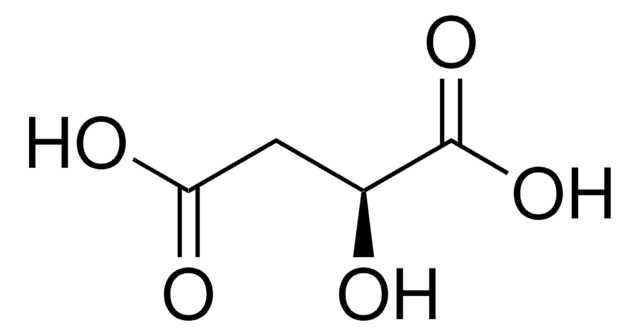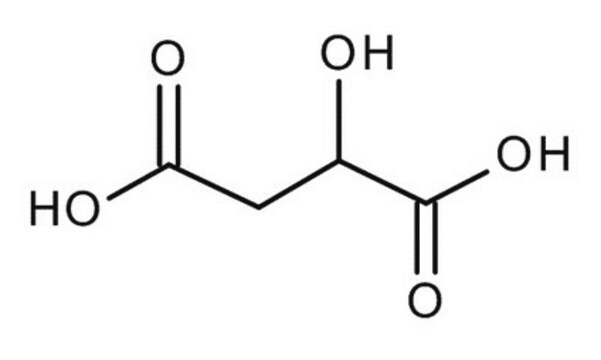Wichtige Dokumente
M8304
Apfelsäure
meets USP/NF testing specifications
Synonym(e):
DL-Apfelsäure, (±)-2-Hydroxysuccinsäure, DL-Hydroxybutandisäure
About This Item
Empfohlene Produkte
Agentur
meets USP/NF testing specifications
Qualitätsniveau
Dampfdichte
4.6 (vs air)
Dampfdruck
<0.1 mmHg ( 20 °C)
Form
solid
Selbstzündungstemp.
644 °F
mp (Schmelzpunkt)
131-133 °C (lit.)
Anwendung(en)
pharmaceutical (small molecule)
Funktionelle Gruppe
carboxylic acid
hydroxyl
SMILES String
OC(CC(O)=O)C(O)=O
InChI
1S/C4H6O5/c5-2(4(8)9)1-3(6)7/h2,5H,1H2,(H,6,7)(H,8,9)
InChIKey
BJEPYKJPYRNKOW-UHFFFAOYSA-N
Suchen Sie nach ähnlichen Produkten? Aufrufen Leitfaden zum Produktvergleich
Verwandte Kategorien
Allgemeine Beschreibung
Anwendung
- Microbiome-metabolomics analysis reveals abatement effects of itaconic acid on odorous compound production in Arbor Acre broilers.: This study explores the role of itaconic acid in reducing odorous compounds in poultry through microbiome and metabolomics analysis (Zhu et al., 2023).
- Influence of Carbon Sources on the Phenolic Compound Production by Euglena gracilis Using an Untargeted Metabolomic Approach.: The research investigates the impact of various carbon sources on phenolic compound production in Euglena gracilis through metabolomics (Bernard and Guéguen, 2022).
- Polymalic acid for translational nanomedicine.: This review highlights the biomedical applications of polymalic acid, focusing on its role in nanomedicine and sustainable production methods (Huang et al., 2022).
- Integrated Proteomics and Metabolomics Analysis of Nitrogen System Regulation on Soybean Plant Nodulation and Nitrogen Fixation.: The study examines the regulatory effects of nitrogen on soybean nodulation and nitrogen fixation using proteomics and metabolomics techniques (Lyu et al., 2022).
- Sustainable production and biomedical application of polymalic acid from renewable biomass and food processing wastes.: This paper discusses the sustainable production of polymalic acid from biomass and its biomedical applications (Zou et al., 2021).
Signalwort
Warning
H-Sätze
Gefahreneinstufungen
Eye Irrit. 2
Lagerklassenschlüssel
11 - Combustible Solids
WGK
WGK 1
Flammpunkt (°F)
397.4 °F
Flammpunkt (°C)
203 °C
Persönliche Schutzausrüstung
dust mask type N95 (US), Eyeshields, Gloves
Hier finden Sie alle aktuellen Versionen:
Besitzen Sie dieses Produkt bereits?
In der Dokumentenbibliothek finden Sie die Dokumentation zu den Produkten, die Sie kürzlich erworben haben.
Kunden haben sich ebenfalls angesehen
Unser Team von Wissenschaftlern verfügt über Erfahrung in allen Forschungsbereichen einschließlich Life Science, Materialwissenschaften, chemischer Synthese, Chromatographie, Analytik und vielen mehr..
Setzen Sie sich mit dem technischen Dienst in Verbindung.





